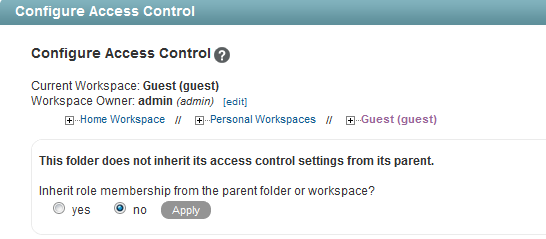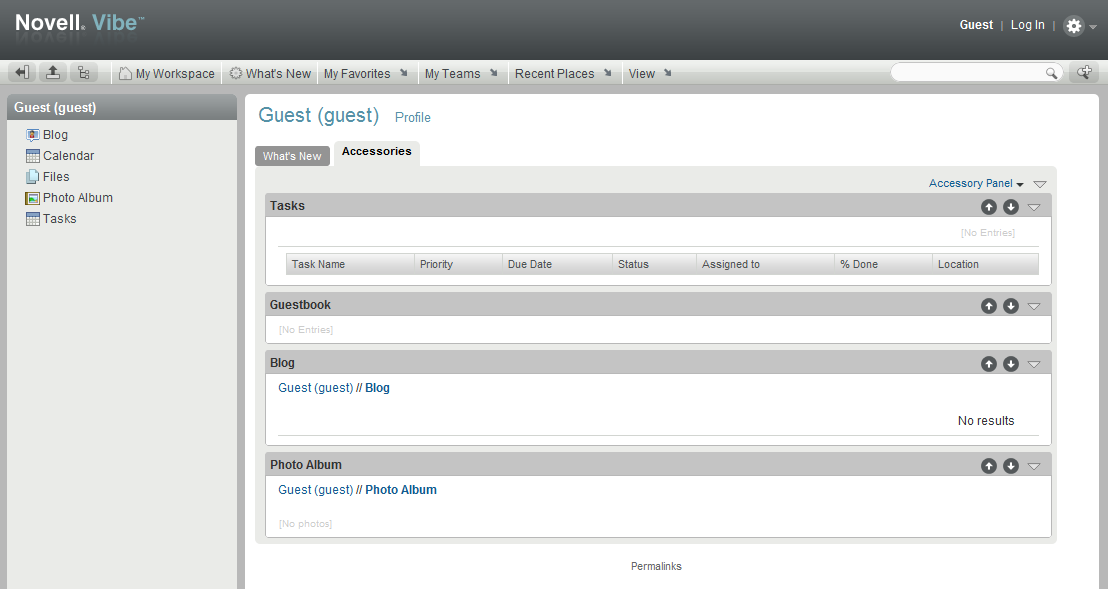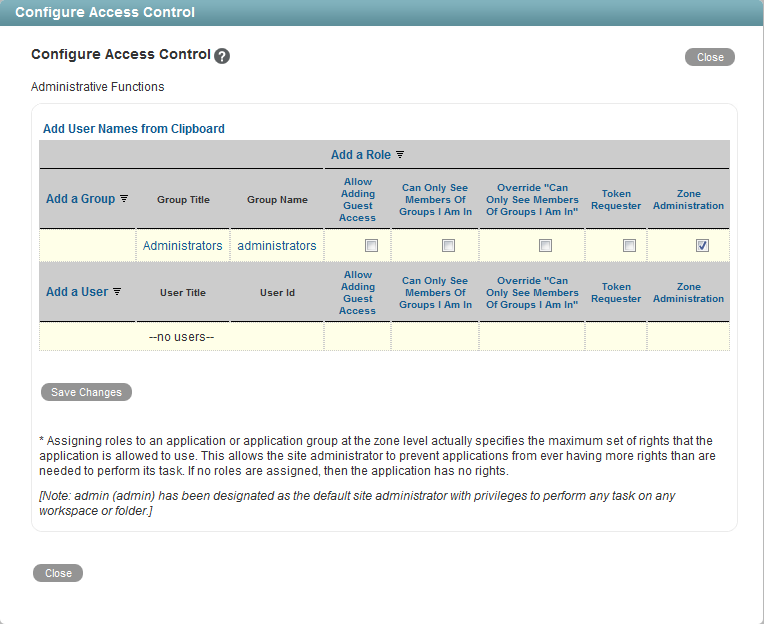5.4 Allowing Guest Access to Your Vibe Site
When a person arrives at the Novell Vibe site URL, the person is considered to be a Guest user on the site, as indicated by the username displayed in the upper right corner of the page:

This page is also the main Vibe login page. Users with Vibe usernames can log in to their personal workspaces, and from there they can access any other locations where they have been granted access.
NOTE:Guest access is not possible if you are using Novell Access Manager to provide single sign-on functionality. For more information about Novell Access Manager, see Configuring Single Sign-On with Novell Access Manager
in Advanced Installation and Reconfiguration
in the Novell Vibe 3.2 Installation Guide.
5.4.1 Understanding the Guest User
As the administrator, you can choose whether you want people who do not have Vibe usernames to be able to access information on the Vibe site as the Guest user.
For example, a government organization such as a city might give Vibe user accounts only to key city knowledge workers. However, it is critical that other city workers and regular citizens also access the site to see a listing of upcoming events, read city news, report complaints, and so forth. As a Vibe administrator, you can use the Guest User workspace as a place to present information to non-registered Vibe users.
When people visit your Vibe site as the Guest user, they can have some or all of the following experiences, depending on the access controls that you set for the Guest user:
-
Any user who knows the Vibe site URL can access the Guest workspace.
-
The Relevance Dashboard in the Guest workspace displays only the information that the Guest user has been specifically granted access to see.
-
A Guest user can find out what is accessible on the Vibe site by clicking the icon
 , selecting , then pressing the Spacebar.
, selecting , then pressing the Spacebar.
-
If a Guest user uses the Search feature, the only information returned is information that the Guest user has been granted access to see.
-
When a Guest user adds a folder entry, the entry form requests the user’s name and e-mail address. This information is displayed like a signature when the folder entry is viewed. Providing the name and e-mail address is optional.
-
If you grant Participant rights to the Guest user, people who access the Vibe site as the Guest user can modify and delete entries and comments posted by other people who have accessed the Vibe site as the Guest user.
5.4.2 Setting Up Guest Access for the Vibe Site
-
Log in to the Vibe site as the Vibe administrator.
-
Click the icon
 in the upper right corner of the page, then click the icon
in the upper right corner of the page, then click the icon  .
.
-
Under , click.

-
Make sure that is selected, then click .
Even though this option is selected by default, the Guest workspace is initially inaccessible because the default user access control settings do not allow access.
-
Click again to close the Administration page.
-
Click the Workspace tree icon, expand , then click .
-
Begin typing Guest in the field, then click it in the drop-down list.
The Guest user’s personal workspace is displayed.
-
Set the user access control settings on the Guest user’s workspace:
-
Click .

-
Change the user access control settings as needed:
Workspace Owner: By default, the Vibe site administrator owns the Guest user’s workspace. Click to specify a new owner, select whether this change applies to folders under the Guest user’s workspace, then click .
Role Membership Inheritance By default, role membership is not inherited. Keep this setting.
-
-
Add the roles that you want the Guest user to be able to perform in the Guest workspace:
-
Click start typing Guest in the field, then click when it appears in the drop-down list.
This adds as a new row in the Access Control table.

-
Select one or more roles that you want the Guest user to be able to perform on the Guest User workspace. For example:
Visitor: The Guest user can read entries and add comments or replies in folders in the Guest user workspace.
Participant: In addition to Visitor activities, the Guest user can also create new entries, and modify or delete his or her own entries.
For more information about the additional access control options, see
Controlling Access
in the Novell Vibe 3.2 Advanced User Guide. -
Click , then click .
Now, when people access the Vibe site who do not have usernames, they are admitted as a Guest user and see the What’s New page (only items that the Guest user has access to see are visible). Guest users can also access the Guest User workspace by clicking .

-
-
Set up the Guest user’s personal workspace with whatever information you want to present to people who visit your Vibe site without logging in.
For general suggestions on creating useful workspaces, see
Creating Custom Workspace Views
in the Novell Vibe 3.2 Advanced User Guide. -
(Conditional) If you want the Guest user to be able to access content elsewhere on the Vibe site, add the Guest user to the Configure Access Control page for those workspaces or folders.
You can also enable specific Vibe users in addition to the Vibe administrator to grant Guest access to locations in your Vibe site, as described in Section 5.4.4, Enabling Individual Users to Grant Guest Access throughout the Vibe Site.
-
Notify people who might be interested in accessing your Vibe site about your Vibe site URL.
-
(Conditional) If you want information on your Vibe site to be searchable on the Internet, see Section 5.6, Allowing Web Crawler Access to Your Vibe Site.
5.4.3 Configuring Any Workspace to Be the Default Home Page for Guest Users
If you’re not satisfied with the What’s New page being the default home page for guest users, you can configure the Guest User workspace or a different workspace to be the default home page, giving you complete control over what guest users see when they first access the Vibe site.
For information on how to change the default home page for guest users, see Section 4.3.2, Setting a Default Home Page for Guest Users.
5.4.4 Enabling Individual Users to Grant Guest Access throughout the Vibe Site
If you want users in addition to the Vibe administrator to be able to grant Guest access to locations in your Vibe site:
-
Log in to the Vibe site as the Vibe administrator.
-
Click the icon
 in the upper right corner of the page, then click the icon
in the upper right corner of the page, then click the icon  .
.
-
Under , click .

A basic Vibe site consists of a single zone. Novell Vibe allows you to set up multiple zones in a single Vibe site. This feature is not available in Kablink Vibe. For more information about zones, see Section 16.0, Setting Up Zones (Virtual Vibe Sites).
-
Click , start typing the user’s name, then select the user from the drop-down list to add the user to the Access Control table.
-
Select the check box in the column.
-
Repeat Step 4 and Step 5 for each user who you want to be able to grant Guest access to locations on your Vibe site.
-
Click , then click .
-
Notify the users who are allowed to grant Guest access.
5.4.5 Monitoring Guest User Access
As the Vibe site administrator, you can create a report of all locations on the Vibe site that the Guest user can access. For instructions, see Section 26.2.3, User Access Report.